#samudra manthana
Photo

New Gods- Churning of the Ocean
#new gods#new genesis#apokolips#fourth world#jack kirby#kalibak#mantis#kanto#darkseid#highfather#metron#big barda#mister miracle#scott free#lightray#orion#samudra manthana
49 notes
·
View notes
Text
ramble time ill prolly delete this later
love this very low energy depiction of the samudra manthana, usually other versions have a wider sense of scale than this but i think its funny . mt mandara is so small. vasuki looks so non-threatening. kurma looks squished. also the asuras just look like straight up animals, usually theyre depicted with animalistic features but you cant tell me that thats not just a straight up goat
there are some things like like abt this though, first of all i dont usually see (or at least I dont notice) specific devas aside from vishnu portrayed at the churning of the ocean of milk, so seeing shiva and brahma there too is cool. i wish i could name that guy in the middle but im having a brainfart moment rn so that might actually just be a miscellaneous deva
i also like how this depiction actually SHOWS what was lost in the ocean of milk, including lakshmi, the amrita, what is probably supposed to be halahala??, an ucchaishrava, surabhi, airavata, chandra, and etc etc. not many samudra manthana pieces actually show what was underwater so thats cool

2 notes
·
View notes
Text


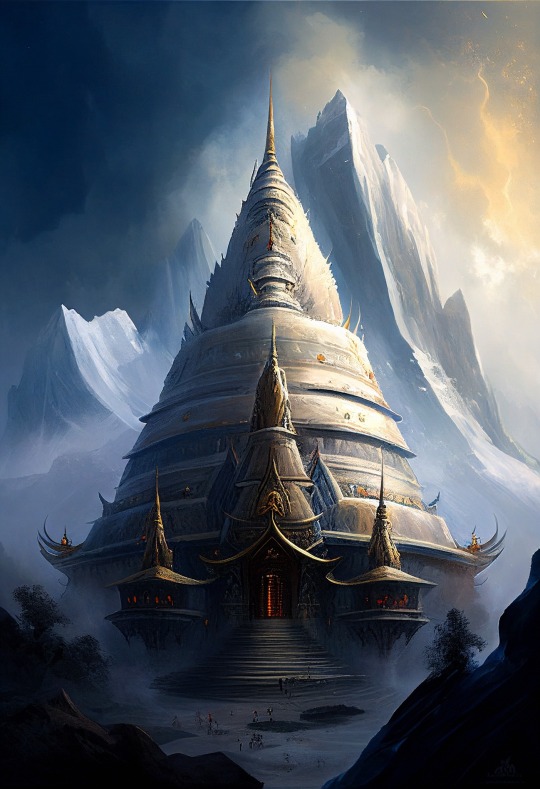
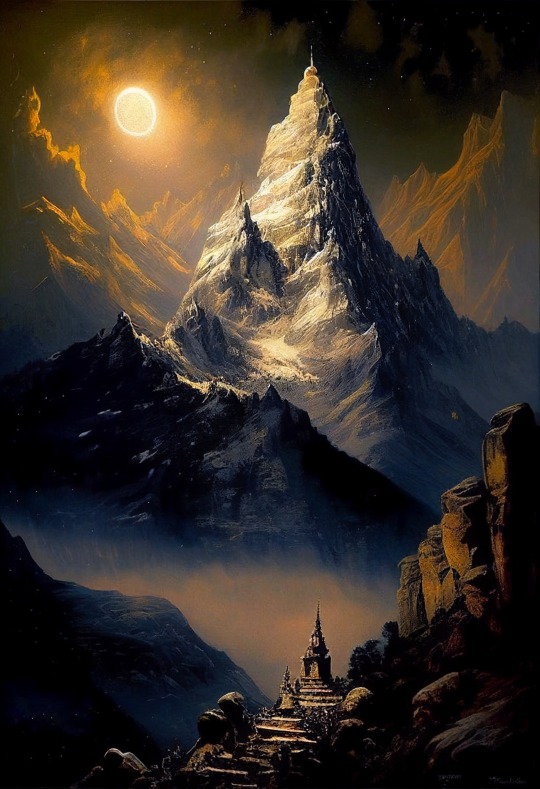
Svarga
“Indra's abode”
Talon Abraxas
Svarga is a set of celestial worlds located on and above Mount Meru, where those who had led righteous lives by adhering to the scriptures delight in pleasures, before their next birth on earth. It is described to have been built by the deity Tvashtar, the Vedic architect of the devas.
The king of the devas, Indra, is the ruler of Svarga, ruling it with his consort, Indrani. His palace in the abode is called Vaijayanta. This palace holds the famous hall, Sudharma, unrivalled among all the princely courts. The capital of Svarga is Amaravati, and its entrance is guarded by the legendary elephant, Airavata.: 84 Svarga is described to be the home of Kamadhenu, the cow of plenty, as well as Parijata, the tree that grants all wishes. The legendary Kalpavriksha tree grows in the centre of the Nandana gardens, which was planted there by Indra after it emerged from the Samudra Manthana, the churning of the ocean. Due to its location, Svarga is called Tridiva, the third highest heaven.
25 notes
·
View notes
Text
The Mahavidya (Sanskrit: महाविद्या, IAST: Mahāvidyā, lit. Great Wisdoms) are a group of ten Hindu[1] Tantric goddesses.[2] The 10 Mahavidyas are usually named in the following sequence: Kali, Tara, Tripura Sundari, Bhuvaneshvari, Bhairavi , Chhinnamasta, Dhumavati, Bagalamukhi, Matangi and Kamala.[3] Nevertheless, the formation of this group encompass divergent and varied religious traditions that include yogini worship, Saivism, Vaishnavism, and Vajrayana Buddhism.[4]
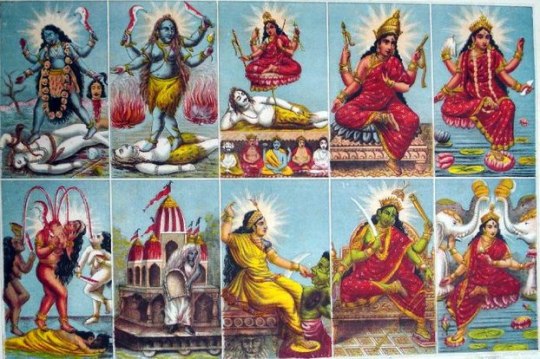
Shaktas believe, "the one Truth is sensed in ten different facets; the Divine Mother is adored and approached as ten cosmic personalities," the Dasa-Mahavidya ("ten-Mahavidyas").[6] As per another school of thought in Shaktism Mahavidyas are considered to be form of Mahakali. The Mahavidyas are considered Tantric in nature, and are usually identified as:[7
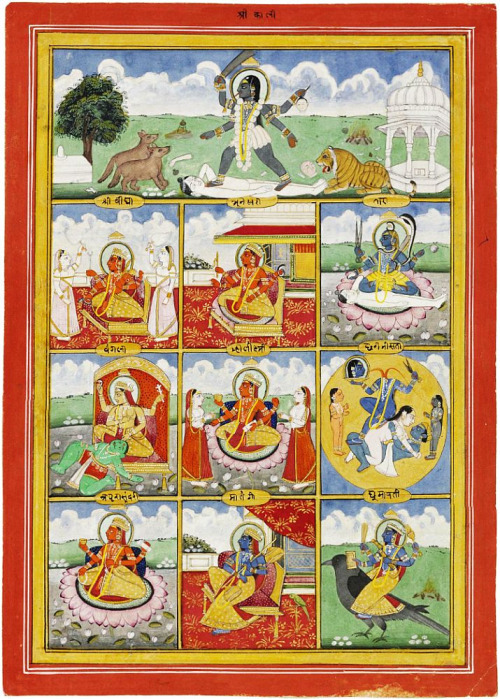
1. Kali: The goddess who is the ultimate form of Brahman, and the devourer of time (Supreme Deity of Kalikula systems). Mahakali is of a pitch black complexion, darker than the dark of the dead of the night. She has three eyes, representing the past, present and future. She has shining white, fang-like teeth, a gaping mouth, and her red, bloody tongue hanging from there. She has unbound, disheveled hairs. She wears tiger skins as her garments, a garland of skulls and a garland of rosy red flowers around her neck, and on her belt, she was adorned with skeletal bones, skeletal hands as well as severed arms and hands as her ornamentation. She has four hands, two of them had the trident called the trishula and the sword and two others carried a demon head and a bowl collecting the blood dripping from a demon head.
2. Tara: The goddess who acts as a guide and a protector, and she who offers the ultimate knowledge that grants salvation. She is the goddess of all sources of energy. The energy of the sun is believed to originate from her. She manifested as the mother of Shiva after the incident of Samudra Manthana to heal him as her child. Tara is of a light blue complexion. She has disheveled hair, wearing a crown decorated with the digit of the half-moon. She has three eyes, a snake coiled comfortably around her throat, wearing the skins of tigers, and a garland of skulls. She is also seen wearing a belt supporting her skirt made of tiger-skin. Her four hands carry a lotus, scimitar, demon head and scissors. Her left foot rests on the laying down Shiva.
3. Tripura Sundari (Shodashi, Lalita): The goddess who is "beauty of the three worlds" (Supreme Deity of Srikula systems); the "Tantric Parvati" or the "Moksha Mukta". She is the ruler of Manidvipa, the eternal supreme abode of the goddess. Shodashi is seen with a molten gold complexion, three placid eyes, a calm mien, wearing red and pink vestments, adorned with ornaments on her divine limbs and four hands, each holding a goad, lotus, a bow, and arrow. She is seated on a throne.
4. Bhuvaneshvari: The goddess as the world mother, or whose body comprises all the fourteen lokas of the cosmos. Bhuvaneshvari is of a fair, golden complexion, with three content eyes as well as a calm mien. She wears red and yellow garments, decorated with ornaments on her limbs and has four hands. Two of her four hands hold a goad and noose while her other two hands are open. She is seated on a divine, celestial throne.
5. Bhairavi: The fierce goddess. The female version of Bhairava. Bhairavi is of a fiery, volcanic red complexion, with three furious eyes, and disheveled hair. Her hair is matted, tied up in a bun, decorated by a crescent moon as well as adorning two horns, one sticking out from each side. She has two protruding tusks from the ends of her bloody mouth. She wears red and blue garments and is adorned with a garland of skulls around her neck. She also wears a belt decorated with severed hands and bones attached to it. She is also decked with snakes and serpents too as her ornamentation – rarely is she seen wearing any jewelry on her limbs. Of her four hands, two are open and two hold a rosary and book.
6. Chhinnamasta: The self-decapitated goddess. She chopped her own head off in order to satisfy Jaya and Vijaya (metaphors of rajas and tamas - part of the trigunas). Chinnamasta has a red complexion, embodied with a frightful appearance. She has disheveled hair. She has four hands, two of which hold a sword and another hand holding her own severed head; three blazing eyes with a frightful mien, wearing a crown. Two of her other hands hold a lasso and drinking bowl. She is a partially clothed lady, adorned with ornaments on her limbs and wearing a garland of skulls on her body. She is mounted upon the back of a copulating couple.
7. Dhumavati: The widow goddess. Dhumavati is of a smoky dark brown complexion, her skin is wrinkled, her mouth is dry, some of her teeth have fallen out, her long disheveled hair is gray, her eyes are seen as bloodshot and she has a frightening mien, which is seen as a combined source of anger, misery, fear, exhaustion, restlessness, constant hunger and thirst. She wears white clothes, donned in the attire of a widow. She is sitting in a horseless chariot as her vehicle of transportation and on top of the chariot, there is an emblem of a crow as well as a banner. She has two trembling hands, her one hand bestows boons and/or knowledge and the other holds a winnowing basket.
8. Bagalamukhi: The goddess who paralyzes enemies. Bagalamukhi has a molten gold complexion with three bright eyes, lush black hair and a benign mien. She is seen wearing yellow garments and apparel. She is decked with yellow ornaments on her limbs. Her two hands hold a mace or club and holds demon Madanasura by the tongue to keep him at bay. She is shown seated on either a throne or on the back of a crane.
9. Matangi: The Prime Minister of Lalita (in Srikula systems), sometimes called the "Tantric Saraswati". Matangi is depicted as emerald green in complexion, with lush, disheveled black hair, three placid eyes and a calm look on her face. She is seen wearing red garments and apparel, bedecked with various ornaments all over her delicate limbs. She is seated on a royal throne and she has four hands, three of which hold a sword or scimitar, a skull and a veena (a musical instrument). Her one hand bestows boons to her devotees.
10. Kamalatmika (Kamala): The lotus goddess; sometimes called the "Tantric Lakshmi". Kamala is of a molten gold complexion with lush black hair, three bright, placid eyes, and a benevolent expression. She is seen wearing red and pink garments and apparel and bedecked with various ornaments and lotuses all over her limbs. She is seated on a fully bloomed lotus, while with her four hands, two hold lotuses while two grant her devotees' wishes and assures protection from fear.
All these Mahavidyas reside in Manidvipa.
The Mahabhagavata Purana and Brihaddharma Purana however, list Shodashi (Sodasi) as Tripura Sundari, which is simply another name for the same goddess.[9] The Guhyati guyha-tantra associates the Mahavidyas with the Dashavatara, the ten avatars of Vishnu, and states that the Mahavidyas are the source from which the avatars of Vishnu arise.

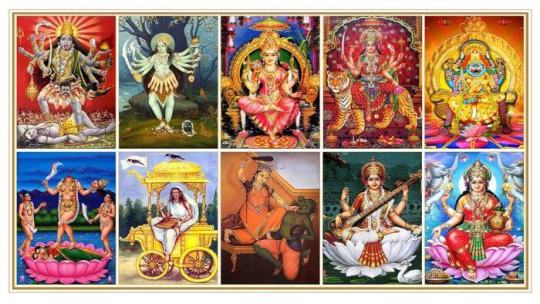

#desi aesthetic#desi tag#desiblr#desi#desi dark academia#desi culture#desi academia#desi stuff#hindu mythology#south asian aesthetic#south asian dark academia#aloukik 2023
38 notes
·
View notes
Text

Spiritual Meaning of Samudra Manthan
The Samudra Manthana is one of the best-known episodes in the Vedic philosophy narrated in the Bhagavata Purana, in the Mahabharata and in the Vishnu Purana.
The story of the Samudra Manthan symbolises the spiritual endeavour of a person, trying to achieve self-realisation by concentrating his mind, withdrawing his senses, controlling his desires and practicing severe penances.
The Devas and the Asuras represent the positives and negatives of one's own self. It represents how, to achieve self-realisation, one must control both sides of his self and balance them in order to reach the goal.
The Mandhara Mountain (Mana - mind; dhara - in one line or flow) symbolises concentration.
Vishnu's Kurma Avatar - symbolises the withdrawal of one's senses - just like a tortoise retracts its head under its shell. It symbolises contemplation through meditation and concentration.
Vasuki - the serpent king - was used as the churning rope, and it signifies the desire to attain the nectar of immortality. It's as if the Devas and Asuras, churned their mind with a rope of desire.
The Ocean of Milk - is the collective human consciousness or the mind.
The Halahal poison - represents the suffering and pain that comes to the fore when one goes through severe penance.
Thus as of now, here's how it stands; As the Devas and the Asuras (the positives and the negatives of one's self), churned the ocean of milk (the mind) for the nectar of immortality (self realisation), with Mount Mandhara (concentration) resting on Vishnu's Kurma Avatar (withdrawing their senses), using Vasuki (desire) as the churning rope, the first thing that came out, was the Halahal poison (pain and suffering) which had to be resolved for further progress.
The precious objects that came out of the ocean of milk represent the psychic or spiritual powers that one is rewarded with, after he continues his penances, having resolved pain and suffering. The Devas and the Asuras distributing these gifts of the oceans symbolises that one needs to use these gifts for common welfare and not for one's personal gains. Only then, could they progress in the epic churning project.
Dhanvantari symbolises health - implying that immortality (or to be more pracitcal, longevity) or in this case, self-realisation can only be obtained through a state of health. The body and mind must be in a state of perfect health for the attainment of this goal.
Mohini - is symbolic of delusion or pride. Once they were very close to their goal, the Devas and the Asuras succumbed to their pride and were deluded. They were thus, led astray. Thus, pride must be overcome before the final truth is attained.
The Amrit or the nectar of immortality that is finally obtained, is symbolic of self realisation, after one has give up his/her pride.
Halahal or Kalakoot (the all-consuming poison): The first thing that evolved from the churning was an all-consuming, supremely powerful poison called Halahal, which gave off such poisonous fumes that both parties began to die from asphyxiation. Where Lord Shiva consuming the poison, symbolises that to resolve the pain and suffering that has resulted out of severe concentration and penance, one needs the qualities of Lord Shiva himself: courage, compassion, willingness, initiative, simplicity, austerity, detachment etc.
The poison is symbolic of all that is unknown, lethal and dangerous in the oceans. Even today, man has not completely conquered the ocean, my interpretation is that the Vedic texts attempted to convey this same message to mankind. Only Lord Shiva holds the power to survive this poison, so he drinks the poison, which starts to have its devastating effect on Shiva.
Witnessing this condition, his wife, the Goddess Parvati places her hand on his throat, and as she is an anthropomorphic representation of Nature, she is successful in localizing the poison’s effects to Shiva’s throat. This is meant to show the love and understanding between a couple. Shiva-Parvati represent the ideal couple, and hence, this is a symbolic reference to their mutual love, respect and concern for each other. Because of this, Shiva’s throat turns blue, and he is also known as Neelkanth (Sanskrit: Neel=blue, kanth=throat)
Following this, 13 gems or Ratnas emerge from the churning, some of them have symbolic insight. (Halahal is considered the first Ratna in some versions, making the total up to 14).
Lakshmi: The Goddess of Wealth, who accepts Lord Vishnu as her consort. It is very fitting that she emerges from the ocean. Even today, we know that the ocean contains vast, unsurpassed reserves of gold, silver, gems, oil, natural gas etc.
Apsaras (divine nymphs): They are taken up by various demigods as consorts. Some comparative history research suggests these are the equivalent of mermaids. No reference in Hindu texts that remotely indicate any such features to the Apsaras, except that both species are known to be very good singers.
Varuni: Represents the tempestuous mood of the oceans, she was taken up (somewhat reluctantly) by the demons. However, in some versions of the story, Lord Varuna (the Hindu God of the Oceans) accepts him as his consort.
Ucchaishravas (the seven-headed horse): This is the equivalent of Pegasus. Ucchaishravas is considered as the king of horses (mankind has always seen horses as a symbol of power, strength and virility) and is taken by Indra, the King of Gods.
Kamadhenu: A divine cow, that grants its owner any wish. Kamadhenu is symbolically related to the form of Devi (the all-giving Mother). She is taken by Lord Vishnu and granted to sages so that the ghee that comes out of her milk can be used for the highest sacrificial offerings. she may also be closely related to the fertility goddess Prithvi (Mother Earth), also sometimes mentioned as a cow in Hindu texts.
Kaustubh: The most resplendent of all jewels, which was so beautiful that the demons and gods started quarreling among themselves as to who would have it. Kaustubh represents the all-consuming greed that can emerge so effortlessly and easily from something beautiful and precious.
This gem is finally worn as an adornment on his chest by Lord Vishnu, because only he is completely detached from the greed associated with riches (because Lakshmi, the Goddess of Wealth is his consort: See how it ties up)
Parijat: A divine, magical tree that has blossoms which give out a sweet perfume. This tree has been identified as Nyctanthes arbor-tristis and research has indeed shown that this tree has medicinal properties. Parijat was taken up by the Gods.
Sharanga: A divine bow emerging from the oceans, symbolic of weapons that can be created from the ocean’s unknown. It is an established fact in Vedic texts that the Sharanga is the most powerful bow (Vishnu once battled Shiva, who also used his bow Pinaka, but was able to successfully defeat Shiva, almost stunning him with his torrential downpour of arrows). Sharanga represents the latent power of the ocean which could be used for creating something as destructive as a divine weapon.
Kalpavriksha: Often mistaken for Parijat. Note that the original legend explicitly mentions the emergence of two distinct trees. Subsequent alterations tend to merge these trees as one. Alternatively called as Kalpataru.
This tree is recorded to give boons to its worshipers, fulfilling their wishes. Even Gods are not exempt from the benefits of this tree. Symbolically speaking, the tree represents Mother Nature and how she holds the potential of controlling certain aspects of even divinity!
Chandra (the moon): Emerges from the ocean and finds place on Lord Shiva’s forehead. At the time of the legend, the Indo-Aryans had some inkling that the patterns of the moon influences spring and neap tides. This is somewhat reflected through the moon emerging from the cosmic ocean. The Milky Way represents this “cosmic ocean” and so it makes sense that the moon emerges as a proper subset of the Milky Way.
Jyestha (the Goddesses of misfortune): In some versions, called as Alakshmi (the opposite of Lakshmi, who is the Goddesses of fortune). Taken up by the demons, she represents the polar equivalent of Lakshmi.
Dhanvantari + amrita: The final result of this churning is the emergence of Dhanvantari, who is then appointed as the Physician of the Gods. He emerges with a kalash (a metallic pot or vessel) that contains amrita, the drink of immortality.
The demons chase him and manage to snatch the pot of immortality, but then quarrel among themselves. The Gods immediately rush to Lord Vishnu to help them.
Lord Vishnu, realizing that evil cannot be made immortal, incarnates into Mohini, a supremely beautiful lady, who is successful in enticing the asuras. Mohini suggests that she divide the drink equally between both parties. Except that she uses Maya (illusion) to swap vessels every time she serves a demon, thus ensuring that evil does not become immortal.
When one of the clever demons himself uses illusion to make him look like a God and drinks the elixir, Mohini reincarnates to her true form as the God Vishnu and uses his serrated discus called the Sudarshan Chakra to cut off the demon’s throat. However, the head (Rahu)of the demon, which had drunk the elixir becomes immortal. The story of the Samudra Manthan has multiple symbolic messages, but for me, the most erudite of them all is the fact that Good always triumphs over Evil.
By - Anadi Sahoo
#samudramanthan #Samudra #sea #searching #Manthan #amrit #poison #Dhantryodashi #laxmi #hindutemples #समुद्र #मंथन #समुद्र_मंथन #विष #कामधेनु #ऐरावत #हाथी #कौस्तुभ #मणि #कल्पवृक्ष #देवी #लक्ष्मी #देवता #समुद्रमंथन #विष्णु #पुराण #hinduism #jaishriram #spiritualgrowth #MeraBharatMahaan
2 notes
·
View notes
Text




Mohini painting - Based on the story of Samudra Manthana from Vishnu puran
Colors - Acrylics
Canvas size - 35cm by 46cm
#mohini#painting#Acrylics#paintings#colors#art#india#canvas#indianart#beautiful#lady#saree#jewellery#attractive
0 notes
Photo

Samudra Manthana, the origin of the elixir of eternal life: Amrita #angkor #angkorwat #siemreap #cambodia #hinduism #carvings #religion #nikon #socnikon #d800 #2470mm #nikkor #lens #igers #igerscatalunya #igerseurope #igersasia #instagood #instapic #bwfilter #polarized #benro #tripod #rhino #globetrotter #noroadtravel #swipe #picoftheday #photooftheday #photography (at Angkor What, Siem Reap) https://www.instagram.com/p/Cmee-CDMoYo/?igshid=NGJjMDIxMWI=
#angkor#angkorwat#siemreap#cambodia#hinduism#carvings#religion#nikon#socnikon#d800#2470mm#nikkor#lens#igers#igerscatalunya#igerseurope#igersasia#instagood#instapic#bwfilter#polarized#benro#tripod#rhino#globetrotter#noroadtravel#swipe#picoftheday#photooftheday#photography
0 notes
Text
Abridge van centre

But it is the steep climb, only for brave hearts.Īngkor Thom was the capital and walled city built in the late 12th to early 13th century by Jayavarman VII, the greatest of the Khmer rulers. At the peak of the Angkor Wat temple built in tiers, is the The spatial dimensions and the architecture of the temple are awe-inspiring enough for one to imagine that it was built by the celestials. The expression of art is pleasing and native. And everywhere in the temples are the hundreds of delicately carved apsaras - so varied in their headdresses, poses and expressions - and so Cambodian. On yet another wall, the blood curdling portrayal of Hell is tempered somewhat by the promised rewards of heaven. The samudra manthana, the churning of the ocean, in a magnificent composition that is a highlight of Angkor Wat, enthrals on the east gallery of the temple. On another wall, we are taken straight into the Kurukshetra war. The chisel appears to have magically turned into a brush that painted simian movements representing all the fury and the excitement of the vanaras as they threw themselves into the great battle to help Rama. Piece de resistance at the Angkor Wat temple comprises the twin bas reliefs, hundreds of metres long, depicting sculpted scenes from the Ramayana and the Mahabharata. The huge image of the eight armed Vishnu - with the head replaced by that of the Buddha after the country became Buddhist - is still worshipped. Built by Suryavarman II in the 12th century, the temple is a grand expression of his faith: in the form of Mount Meru, the centre of the Universe, where the gods are believed to reside, and surrounded by a moat to represent the ocean, courtyards to represent the continents, and towers to represent the peaks. From the ninth to the 14th centuries, successive kings built splendid temples to Siva and Vishnu, adorned with sculptures of graceful apsaras and valorous gods, endearing faced Nagas and upright lions.Īt the oft-visited site of Angkor Wat, the scale and magnificence of the structures take one’s breath away. It stretches on a wall 49 metres in length of this temple, the largest religious site in the world, and a famed example of cultural transfer.įrom South India, according to legend, came the Brahmin, who defeated the ruling Naga princess and then married her. They live in an eternal tug-of-war in the temples of Angkor Wat, Banteay Samre, Bayon, the causeway to Preah Khan.Īt Angkor Wat the depiction of the combat goes back to a thousand years. They stand, enormous legs braced on the ground, as they pull the serpent Vasuki as a rope, and churn away at the Ocean of milk. The devas and asuras still exist in the form of gigantic sculptures of the former Khmer Empire in Siem Reap province, Cambodia.

0 notes
Photo
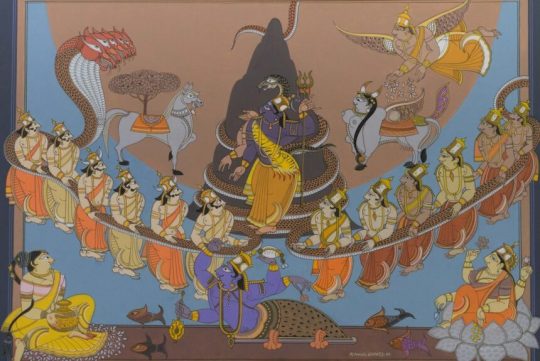
Samudra Manthana, The churning of the Ocean of Milk by Kamal
41 notes
·
View notes
Photo

The Samudra Manthana (Sanskrit: समुद्रमन्थन, lit. churning of the ocean) is one of the best-known episodes in the Hindu philosophy narrated in the Bhagavata Purana, in the Mahabharata and in the Vishnu Purana. The Samudra Manthana explains the origin of Amrita, the nectar of immortality and the omnipotent god of destruction Shiva drank the vish.
15 notes
·
View notes
Text

Samudra Manthana by Sura and Asuras
#hindu#hinduism#spirituality#temple#shiva#hindu mythology#lordshiva#parvati#kailasa#samudra manthan#sanathandharma#mahavishnu#vishnu
41 notes
·
View notes
Text
Amrita
Mohini, the female form of Vishnu, holding the pot of amrita which she distributes amongst all the devas, leaving the asuras without. Darasuram, Tamil Nadu, India
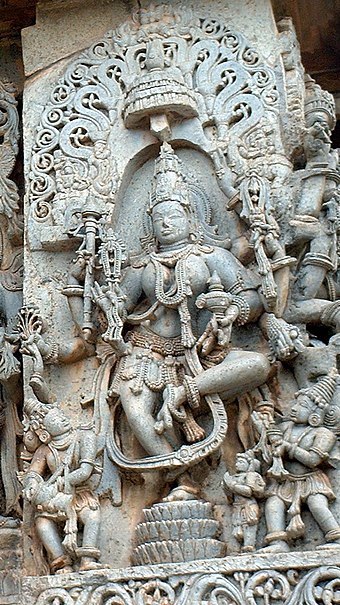
Amrita (Sanskrit: अमृत, IAST: amṛta), Amrit or Amata (also called Sudha, Amiy, Ami) is a word that literally means "immortality" and is often referred to in ancient Indian texts as nectar. "Amṛta" is etymologically related to the Greek ambrosia[1] and carries the same meaning.[2] Its first occurrence is in the Rigveda, where it is considered one of several synonyms for soma, the drink of the devas.
Amrit has varying significance in different Indian religions. The word Amrit is also a common first name for Sikhs and Hindus, while its feminine form is Amritā. The traditional masculine name is Amrith with the feminine name being Amritha.
Hinduism
Amrita is repeatedly referred to as the drink of the devas, which grants them immortality. Despite this, the nectar does not actually offer true immortality. Instead, by partaking it, the devas were able to attain a higher level of knowledge and power, which they had lost due to the curse of Sage Durvasa, as described in the samudra manthana legend. It tells how the devas, after the curse, begin to lose their immortality. Assisted by their rivals, the asuras, the devas begin to churn the ocean, releasing (among other extraordinary objects and beings) the amrita.[3]
Amrita is sometimes said to miraculously form on, or flow from, statues of Hindu gods. The substance is consumed by worshippers and is alleged to be sweet-tasting and not at all similar to honey or sugar water. Amrita was the last of the fourteen treasures that emerged from the churning of the ocean and contained in a pot borne by Dhanvantari, the physician of the devas.
Sikhism
In Sikhism, amrit (Punjabi: ਅੰਮ੍ਰਿਤ) is the name of the holy water used in Amrit Sanchar, a ceremony which resembles baptism. This ceremony is observed to initiate the Sikhs into the Khalsa and requires drinking amrit. This is created by mixing a number of soluble ingredients, including sugar, and is then rolled with a khanda with the accompaniment of scriptural recitation of five sacred verses.
Metaphorically, God's name is also referred to as a nectar:
ਅੰਮ੍ਰਿਤ ਸਬਦੁ ਅੰਮ੍ਰਿਤ ਹਰਿ ਬਾਣੀ ॥
Amrit sabad amrit har baṇi.
The Shabda is Amrit; the Lord's bani is Amrit.
ਸਤਿਗੁਰਿ ਸੇਵਿਐ ਰਿਦੈ ਸਮਾਣੀ ॥
Satgur seviai ridai samāṇi.
Serving the True Guru, it permeates the heart.
ਨਾਨਕ ਅੰਮ੍ਰਿਤ ਨਾਮੁ ਸਦਾ ਸੁਖਦਾਤਾ ਪੀ ਅੰਮ੍ਰਿਤੁ ਸਭ ਭੁਖ ਲਹਿ ਜਾਵਣਿਆ
Nānak amrit nām sadā sukhdāta pi amrit sabh bhukh lėh jāvaṇia.
O Nanak, the Ambrosial Naam is forever the Giver of peace; drinking in this Amrit, all hunger is satisfied.[4]
Theravada Buddhism
According to Thanissaro Bhikkhu, "the deathless" refers to the deathless dimension of the mind which is dwelled in permanently after nibbana.[5]
In the Amata Sutta, the Buddha advises monks to stay with the four Satipatthana: "Monks, remain with your minds well-established in these four establishings of mindfulness. Don't let the deathless be lost to you."[6]
In the questions for Nagasena, King Milinda asks for evidence that the Buddha once lived, wherein Nagasena describes evidence of the Dhamma in a simile:
"Revered Nagasena, what is the nectar shop of the Buddha, the Blessed One?"
"Nectar, sire, has been pointed out by the Blessed One. With this nectar the Blessed One sprinkles the world with the devas; when the devas and the humans have been sprinkled with this nectar, they are set free from birth, aging, disease, death, sorrow, lamentation, pain, grief and despair. What is this nectar? It is mindfulness occupied with the body. And this too, sire, was said by the Blessed One: 'Monks, they partake of nectar (the deathless) who partake of mindfulness that is occupied with the body.' This, sire, is called the Blessed One's nectar shop."
— Miln 335[7]
Vajrayana Buddhism
Amrita (Wylie: bdud rtsi, THL: dütsi) also plays a significant role in Vajrayana Buddhism as a sacramental drink which is consumed at the beginning of all important rituals such as the abhisheka, ganachakra, and homa. In the Tibetan tradition, dütsi is made during drubchens - lengthy ceremonies involving many high lamas. It usually takes the form of small, dark-brown grains that are taken with water, or dissolved in very weak solutions of alcohol and is said to improve physical and spiritual well-being.[8]
The foundational text of traditional Tibetan medicine, the Four Tantras, is also known by the name The Heart of Amrita (Wylie: snying po bsdus pa).
The Immaculate Crystal Garland (Wylie: dri med zhal phreng) describes the origin of amrita in a version of the samudra manthana legend retold in Buddhist terms. In this Vajrayana version, the monster Rahu steals the amrita and is blasted by Vajrapani's thunderbolt. As Rahu has already drunk the amrita he cannot die, but his blood, dripping onto the surface of this earth, causes all kinds of medicinal plants to grow. At the behest of all the Buddhas, Vajrapani reassembles Rahu who eventually becomes a protector of Buddhism according to the Nyingma school of Tibetan Buddhism.
Inner Offering (Wylie: Nang chod, Chinese: 内供) is the most symbolic amrita offering assembly, and the Inner Offering Nectar Pill (Wylie: Nang chod bdud rtsi rilbu, Chinese: 内供甘露丸) is a precious and secret medicine of Tibetan Buddhism, which are only used internally for higher ranking monks in Nyingma school. Its ingredients including Five Amrita and Five Meat, which represents five buddha, and five elements respectively. According to Tantras of Chakravarti, and Tantras of Vajravārāhī, a ceremony needs to be hold for melting and blessing the Inner Offering Nectar. Five Nectar needs to be arranged in four directions: yellow excrement in the east, green bone marrow in the north, white semen in the west and red blood in the south, blue urine is placed in the center. Four Nectar should come from wise monks and the ova should be collected from the first menstruation of a blessed woman. The Five Meats are arranged similarly, meat of black bull in the southeast, the meat of the blue dog in the southwest, the meat of the white elephant in the northwest, the meat of the green horse in the northeast, and the meat of a red human corpse in the center. After the ceremony, these ingredients will transform into an one taste (ekarasa) elixir, which bestows bliss, vitality, immortality and wisdom. Actual modern practitioner will take a 'synthesized essence' of the Nectar Pill and combined it with black tea or alcohol, but mostly the "Nectar Pill" are derived from plants.[9]
Chinese Buddhism describes Amrita (Chinese: 甘露; pinyin: gānlù) as blessed water, food, or other consumable objects often produced through merits of chanting mantras.
See also
Ameretat
Ambrosia
Mata Amritanandamayi
Panchamrita
Peaches of Immortality
Soma
Traditional Tibetan medicine
73 notes
·
View notes
Text
I really loved it💝 @Suvanabhumi Thailand airport .
If you fly out from the new Bangkok ‘Suvarnabhumi’ International Airport, the huge, colourful and impressive mythical statue popular in Thai and Indian culture, the 3-headed serpent Naga (his name Vasuki) in a spectacular tug-of-war scene with its mid-section body wrapped around a stone, which is actually a mountain, and Vishnu one of the supreme deities in Hindu is sitting on top, will greet you as you finish immigration and step inside the airport’s duty free shopping area.
You just have to stop and be dazzled by it.
This statue depicts famous incident of #Samudra Manthana.
asiatravelphotography #travelinspiration #travler #traveldiaries #travelphotography📷 #thailand #nature #naturelovers #travellers #Follow
instagram
1 note
·
View note
Text

How did our #ancestors make this?
Isn't it amazing to see this intricately carved rotating pillar made from a single piece of stone with ball-bearing like arrangements at the bottom & top. The pillar is believed to be rotated to perform certain religious rituals in olden times.
The entire pillar space is covered with fine filigree work along with the reliefs depicting episodes, such as Samudra Manthana, Ravana shaking Mount Kailash, many deities etc.
Narsimha_Pillar
Chennakeshava Temple
Belur, Karnataka.
0 notes

